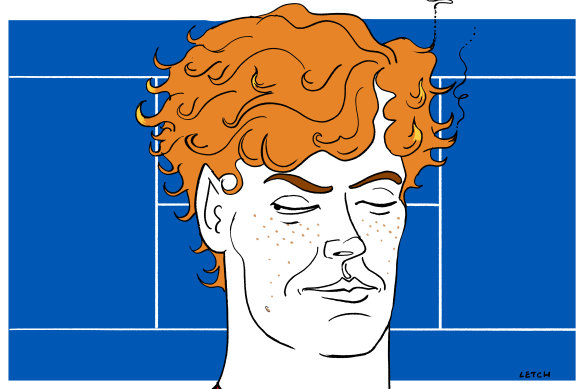This was published 10 months ago
Opinion
Kyrgios has (sort of) got it right about Sinner’s doping offence
Darren Kane
Sports ColumnistIs tennis player Jannik Sinner a drug cheat?
Nick Kyrgios certainly appears to think so. He has opined that it’s beyond the threshold of what’s “ridiculous” that the Italian has escaped any ban of years or even just months after testing positive (twice) earlier in 2024 for the presence of a metabolite of an anabolic agent, Clostebol.

Jannik Sinner has escaped a ban despite twice testing positive to a metabolite of an anabolic agent.Credit: Simon Letch
Last week, an independent tribunal established under the rules of the International Tennis Integrity Agency and its Tennis Anti-Doping Program’s rules determined first that Sinner committed two anti-doping rule violations relating to Clostebol, but that second, Sinner bears no fault or negligence in relation to the commission of those violations. That means any period of ineligibility is eliminated.
Kyrgios is entirely correct in that any such determination, involving a straightforward case of an athlete testing positive to a prohibited substance, warrants careful examination.
Hypothetically, that blowtorch of scrutiny might still be ignited. Article 13.2 of the ITIA’s anti-doping rules says that the decision of the ITIA tribunal is appealable to the Court of Arbitration for Sport, by interested parties. Kyrgios can’t appeal, but the ITIA, the World Anti-Doping Agency and the national anti-doping organisations of the place where Sinner lives (Monaco) or Italy (because he’s Italian) all can.
The time for filing any such appeal is 21 days from the date of the decision, but later if WADA appeals and requests the ITIA’s entire case file. In any appeal, the procedure is that an entirely new hearing takes place, with all of the evidence examined afresh and with new evidence and new submissions able to be made by all parties.
The short point is that for Sinner, it’s conceivable that the saga ain’t over. The question then becomes one of if, on a consideration of the ITIA tribunal’s decision, there should be an appeal commenced.
Kyrgios’ opprobrium vis-à-vis the ITIA’s decision is rooted in the idea that if an athlete tests positive, twice, for the presence of an anabolic steroid, that should equate to the affected athlete being automatically “gone” for two years.
Kyrgios, though, isn’t a lone tomato-thrower here. On August 21, the Canadian player Denis Shapovalov posted on X: “Can’t imagine what every other player that got banned for contaminated substances is feeling right now.”
The respective positions of Kyrgios and Shapovalov are understandable. But their opinions are also misguided, and somewhat facile.
To the main thrust of Kyrgios’ contentions, the ITIA’s doping rules, based on WADA’s rules, are complex. Navigating the byzantine labyrinth of words is a harder task than saying that a positive test(s) for a prohibited substance results in a playing ban of a predetermined duration.
We’re all conditioned to conclude that athletes and anabolic steroids definitely equals bad consequences. The East Germans took anabolic steroids. Anabolic steroids are “old” doping. I understand where Kyrgios’ reasoning comes from, even if matters are actually more complex.

Nick Kyrgios clearly believes Jannik Sinner is a drug cheat.Credit: Getty/Fairfax Media/Aresna Villanueva
To Shapovalov’s point, it is clear enough on a reading of the tribunal’s decision in Sinner’s case, that this isn’t a case of “contaminated substances”. Moreover, the ITIA’s WADA-compliant rules do deal with the realities that someone can breach anti-doping rules through using a “contaminated product”.
A critical reading of the ITIA’s decision, to absolve Sinner from sin, is warranted. Remember, we have the world’s highest-ranked tennis player being found guilty of two anti-doping rule violations relating to the presence and use of a prohibited anabolic agent, and yet we have the same player free and untroubled by any sanction.
Sinner’s case isn’t a contamination case. It shouldn’t be conflated with the myriad issues related to the exoneration of 23 Chinese athletes in 2021, by their country’s own anti-doping agency after an after-the-fact “investigation” conducted by a department of the Chinese secret police.
Rather, Sinner’s case turns on whether he bears any fault or negligence in relation to having tested positive for the anabolic agents, and answering the question of whether he discharged his duty to relevantly exercise utmost caution. Specifically, Sinner’s case concerns a factual narrative of his fitness coach purchasing an over-the-counter medical spray, Trofodermin, which contains Clostebol.

Canadian Denis Shapovalov has also expressed doubts about the Sinner ruling.Credit: Getty Images
From evidence at the tribunal, the coach gave the medical spray to Sinner’s physiotherapist, to treat a cut on the physiotherapist’s hand, apparently accidentally inflicted by a scalpel that the physiotherapist keeps for the purpose of cutting callouses off Sinner’s feet. The fitness coach “recommended” the use of Trofodermin, such is its “healing and antiseptic qualities”.
The physiotherapist used the spray, but didn’t bother to check its contents. Which is fine and would have been inconsequential, but for the fact he also gave Sinner a series of “full-body massages” in the nine-day period he used the spray while his finger was healing.
To prove a defence of no fault or negligence, an athlete must prove not only the origin of the prohibited substance and not just a hypothesis of a potential source, but also that they’d exercised utmost caution despite using the prohibited substance.
In the proceedings before the ITIA tribunal, there wasn’t a serious contest as to the origin of the prohibited substance being through the massages. Evidence from three expert witnesses is best summarised by saying that the “massage hypothesis” – as being the route of administration – was highly plausible.
The more essential question is one of the extent to which Sinner discharged his own, non-delegable burden of exercising utmost caution, bearing in mind that the defence should be available only in properly exceptional cases. The word “utmost” connotes extreme caution and the idea that the athlete could do no more; hypervigilance bordering on fanaticism.

Jannik Sinner takes on Daniil Medvedev in the final of this year’s Australian Open.Credit: Eddie Jim
Successful no-fault or negligence defences used to be tremendously rare, and must remain so given the automatic consequence of the finding is exoneration. The defence is only available in unique factual situations, where the athlete has no involvement – whether by act, negligence or omission – in committing the offence.
The defence should remain the true exception. The archetypal example is that of an athlete who is administered a prohibited substance during surgery and under general anaesthetic.
Successful cases have included that of tennis player Richard Gasquet, who was adjudged by the CAS to have exercised utmost caution in nonetheless ingesting cocaine through kissing an attractive stranger named Pamela in an “unsuspicious environment”.
The ITIA tribunal determined that, based on all the evidence, Sinner is a person who ordinarily exercises considerable caution in relation to doping matters and corresponding precautions, where he also couldn’t have known, even with the utmost of caution, that the fitness coach and physiotherapist had been, and were, using the Trofodermin.
There isn’t any question that Sinner isn’t culpable. There’s no evidence he chose to use Clostebol or have it administered to him. But that’s not the relevant test anyway.
On balance – and I never thought I’d say this – I tend to agree with Kyrgios, albeit for entirely different reasons. Sinner’s case likely sets too low a bar, for what is expected of an athlete in terms of them exercising utmost caution – a standard of leaving not even the smallest of stones unturned.
Did Sinner do all that’s humanly possible to protect himself from inadvertent doping and nonetheless fall foul? I reckon not. He took significant precautions, yes. But that isn’t enough.
Whether WADA appeals the Sinner decision is an entirely different question and one that should be conflated with WADA’s appetite for challenging the findings regarding the 23 Chinese swimmers …
Sports news, results and expert commentary. Sign up for our Sport newsletter.